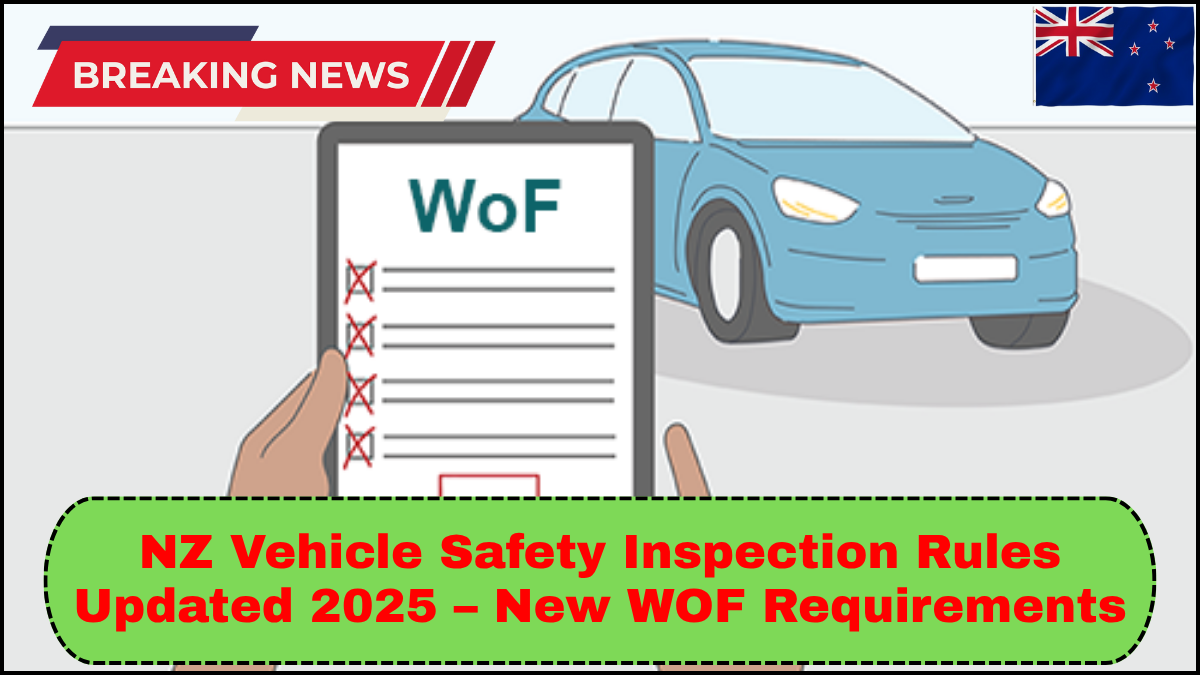New Zealand’s transport authority has rolled out a significant update to its vehicle inspection system, aimed at strengthening road safety and modernizing compliance standards. The NZ Vehicle Safety Inspection Rules Updated 2025 bring new criteria to the forefront, especially in relation to Warrant of Fitness (WOF) assessments. These changes reflect a shift toward stricter regulations, improved roadworthiness checks, and a more future-ready vehicle fleet.
Here’s a complete breakdown of what’s changed, what vehicle owners need to know, and how these updates will affect WOF inspection processes across the country.

What Has Changed in the 2025 Vehicle Safety Rules?
The updated 2025 vehicle safety inspection rules focus on enhancing accountability, adopting newer technology, and addressing longstanding gaps in the inspection framework. These revisions are now mandatory for all light vehicles undergoing a WOF inspection NZ 2025 and apply nationwide.
Key rule changes include:
-
Digital Integration in Inspections: All certified inspectors must now use standardized digital tools for data logging, defect recording, and photo documentation of key inspection points. This ensures more transparency and uniform reporting.
-
Expanded Inspection Scope: Inspectors must now assess additional components, including advanced driver assistance systems (ADAS), electric vehicle battery enclosures, and tyre pressure monitoring systems (TPMS).
-
Revised Thresholds for Wear and Damage: The acceptable wear limits for brake pads, suspension components, and steering parts have been tightened to prevent marginal cases from passing.
-
Rust and Corrosion Focus: New thresholds mandate a more rigorous check for underbody corrosion, especially for imports and coastal vehicles.
-
Mandatory Recalls Compliance: Vehicles with outstanding safety-related recalls will automatically fail the WOF unless proof of recall servicing is provided.
How These Changes Impact Vehicle Owners
For everyday vehicle owners, the NZ Vehicle Safety Inspection Rules Updated 2025 mean more preparation before heading in for a WOF check. Here’s what to expect:
-
Pre-Inspection Costs May Rise: Owners may need to address minor issues in advance to avoid a failed WOF. Mechanics now recommend pre-checks, especially for older vehicles.
-
EV and Hybrid Owners Take Note: The 2025 changes are particularly relevant for electric and hybrid vehicles, as the inspection now includes high-voltage cable shielding, insulation, and battery housing integrity.
-
More Frequent Failures for Neglected Vehicles: The new rules aim to catch borderline cases. Poorly maintained or rarely serviced vehicles are likely to fail under the updated criteria.
Why the Rule Changes Matter
The changes align with New Zealand’s broader transport safety strategy, aiming to reduce crash fatalities linked to mechanical failures. According to Waka Kotahi, nearly 12% of road accidents involved vehicles with some form of mechanical defect in recent years. These vehicle safety check enhancements are intended to close that gap and create a more reliable vehicle fleet.
Furthermore, the new rules support climate goals by enforcing stricter standards on older, more polluting vehicles while encouraging compliance from newer, cleaner models.
Industry and Inspector Readiness
Workshops and inspection centers across New Zealand have received updated training and software to ensure smooth adoption. Certification bodies are also conducting audits to ensure compliance with the new processes.
In many cases, inspection stations are now equipped with smart diagnostics tools and mobile reporting apps, allowing WOF results to be stored in real-time and shared securely with vehicle owners.
Tips to Pass Your 2025 WOF Inspection
To avoid unexpected costs or delays, vehicle owners are advised to:
-
Check all lights, including fog and reverse lights.
-
Ensure tyres are evenly worn and properly inflated.
-
Get the brakes, steering, and suspension inspected by a professional before the WOF.
-
Confirm there are no outstanding manufacturer recalls for your vehicle.
-
For EVs, make sure the battery compartment and cables are undamaged and dry.
Frequently Asked Questions (FAQ)
Q1: What vehicles are affected by the NZ Vehicle Safety Inspection Rules Updated 2025?
All light vehicles (cars, vans, SUVs) that require a WOF inspection in NZ from January 1, 2025, must comply with the new rules.
Q2: Will the cost of WOF inspections increase in 2025?
While the base fee may remain unchanged, additional checks might lead to higher pre-inspection or repair costs, especially for older or modified vehicles.
Q3: Are the new rules stricter on electric vehicles?
Yes. The new inspection includes specific checks on EV battery housings, high-voltage cabling, and electronic safety systems.
Q4: How do I know if my vehicle has an outstanding recall?
You can check using your Vehicle Identification Number (VIN) on the manufacturer’s website or contact your local dealership.
Q5: What happens if my car fails under the new rules?
You’ll receive a detailed report. Once the listed issues are repaired, you can return for a re-inspection. Partial re-inspections are still allowed within a limited time frame.
click here to learn more